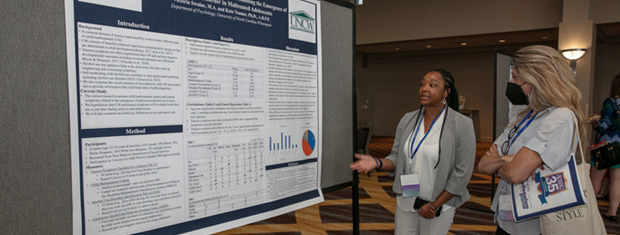




The APSAC Alert is a digital publication of the American Professional Society on the Abuse of Children.
Its purpose is to provide a brief summary of a critical body of empirical research directly informing multidisciplinary
child abuse practice, including professionals who work in mental health, social service, health, and the law.
 This library contains Alerts dating back to 2010. Many issues of the APSAC Alert are available in Spanish.
This library contains Alerts dating back to 2010. Many issues of the APSAC Alert are available in Spanish.
The most recent issue appears at the top. Scroll down to select past issues by year and issue title.
Once a publication appears in the box, you can use the Enlarge button to open the document in a new window or tab
(depending on how your browser is set up). This will allow you to view the document with larger print.
To print a document, first use the Enlarge button to open the document in a new window or tab. Then use your browser's Print command.
To return here from a new tab, close the tab. To return from a new window, click your browser's Back button.
In the listing below, click on a year and issue number to see the articles in that publication.
2011
2011 Fall
What Is My Next Question? Using Question Frameworks to Improve Children's Narrative Accounts of AbuseThe field of child forensic interviewing draws upon accepted practices in the areas of question formation, knowledge of children’s language development, and the development of interview protocols such as the National Institutes of Child Health and Human Development (NICHD) and Corner- House’s Rapport, Anatomy Identification, Touch Inquiry, Abuse, and Closure (RATAC) protocols. Building upon these foundations, how can the interviewer’s question framework maximize children’s ability to report their experience? This article offers practical strategies to improve the clarity, accuracy, and level of detail children provide by emphasizing the need to structure interview question frameworks in response to children’s narrative accounts of abuse.
El campo de la interrogación forense de niños hace uso de las prácticas reconocidas en los áreas de la formación de las preguntas, del conocimiento del desarrollo de la lengua de los niños, y del desarrollo de los protocolos de una entrevis- ta como Los institutos nacionales de la salud de niños y del desarrollo de los seres humanos [NICHD] y La compenetración de CornerHouse, la identidad de anatomía, la investigación táctil, los malos tratos, y los protocolos de cierre [RATAC]. Al basarse en estos fundamentos, ¿cómo puede maximizar el marco de las preguntas del entrevistador la habilidad del niño a contar sus experiencias? Este artículo ofrece unas estrategias prácticas para mejorar la claridad, la exactitud, y el nivel de detalles que un niño puede proveer por poner énfasis en la necesidad de formular los marcos de interrogación de una entrevista en respuesta a las versiones narrativas de los malos tratos a la infancia.
2011 Spring
The Questionable Legitimacy of Pediatric Bipolar DisorderUntil relatively recently, a diagnosis of bipolar disorder in children under the age of 12 was extremely rare. Before the 1990s, it was generally accepted that bipolar disorder was typically first expressed in the late teens or early 20s. In the past 20 years, there has been a 40-fold increase in the number of children and adolescents diagnosed with bipolar disorder. This diagnosis is varyingly referred to as juvenile bipolar disorder, pediatric bipolar disorder, or childhood bipolar disorder. In this article, I focus on diagnosing bipolar disorder in prepubertal and very young children, and I use the term pediatric bipolar disorder (PBD).
Hasta relativamente hace poco, un diagnóstico del trastorno bipolar en niños menor de 12 años fue sumamente raro. Antes de los noventa, por lo general, fue aceptado que el trastorno bipolar típicamente se manifestó por primera vez a fines de la adolescencia o a los veinte y pocos. Durante los últimos 20 años, ha habido un aumento de 40 veces mayor en el número de niños y adolescentes diagnosticados con el trastorno bipolar . Este diagnóstico también se identifica como el trastorno bipolar juvenil, el trastorno bipolar pediátrico, o el trastorno bipolar de niñez. En este artículo, voy a concentrar en el diagnóstico del trastorno bipolar en niños prepúberes y en niños muy jóvenes, y uso el término trastorno bipolar pediátrico (TBP).
2011 Summer
Credentialing Forensic InterviewersLeaders from APSAC and the National Child Protection Training Center (NCPTC) and the National Association of Certified Child Forensic Interviewers (NACCFI) have been working together to develop a multi-tiered credentialing proposal that recognizes basic standards for the field but also allows forensic interviewers to grow professionally. This summary provides an outline of a multi-tiered credentialing process, summarizes responses from front-line professionals, offers some thoughts on the benefits of a credentialing process, and responds to some of the concerns raised by several national leaders as well as front-line professionals. For the full article and references, please see the APSAC Advisor, Summer 2011.
2011 Winter
Supporting CPS Staff Following a Child Fatality or Other Critical IncidentsIn 2009, over 64,700 reports of child abuse and neglect involving more than 90,000 children were made in New York City (NYC Administration for Children’s Services, 2010). As first responders to these difficult and demanding cases, Child Protective Service (CPS) workers often deal with traumatic events related to their work, such as child fatalities, severe child physical and sexual abuse, and violence directed toward them while in the field.
En el 2009, más de 64, 700 denuncias de abuso y abandono infantil involucrando a más de 90, 000 niños fueron hechas en la ciudad de Nueva York (Administración de Servicios para Niños de la Ciudad de Nueva York, 2010). Como primeros respondedores a estos casos difíciles y exigentes, los trabajadores de los Servicios de Protección de Menores (CPS por sus siglas en inglés) a menudo tratan con eventos traumáticos relacionados con su profesión, tales como muertes de niños, abuso físico y sexual severo de niños y la violencia dirigida hacia ellos mientras en sus trabajos.